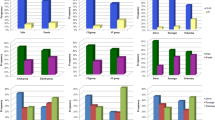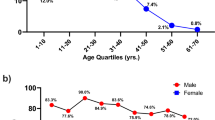Abstract
Purpose
We investigated the incidence and pattern of traumatic fractures resulting from motor vehicle collisions in a population of children and adolescents (≤18 years old) and to determine the risk factors for nerve injury.
Methods
We retrospectively reviewed 734 patients admitted to our university-affiliated hospitals from 2001 to 2010.
Results
This study enrolled 498 male (67.8%) and 236 female (32.2%) patients aged 10.9 ± 5.3 years old. The most common injuries were to pedestrians, and the most common fracture sites (438, 59.7%) were to lower extremities (n = 441, 60.0%). A total of 201 (27.4%) patients experienced a nerve injury. Univariate logistic regression analysis showed that age (P = 0.014), lower-extremity (P = 0.000), craniofacial (P = 0.000) and spinal (P = 0.000) fractures were risk factors for nerve injury. Multivariate logistic regression analysis indicated that craniofacial [odds ratio (OR) = 9.003, 95% confidence interval (CI) 5.159–15.711, P = 0.000)] and spinal (experiencedOR = 10.141, 95% CI: 4.649–22.121, P = 0.011) fractures were independent risk factors for nerve injury.
Conclusions
Patients in the 15- to 18-years old group and drivers had the largest sex ratio and highest frequencies of both nerve injury and early complications. Craniofacial and spinal fractures were independent risk factors for nerve injury. It is therefore important to focus on these risk factors to determine the presence of a nerve injury so that early, timely diagnosis and targeted treatment can be provided.


Similar content being viewed by others
References
Jones G, Cooley HM (2002) Symptomatic fracture incidence in those under 50 years of age in southern Tasmania. J Paediatr Child Health 38(3):278–283
Mattila V, Parkkari J, Kannus P, Rimpelä A (2004) Occurrence and risk factors of unintentional injuries among 12- to 18-year-old Finns--a survey of 8219 adolescents. Eur J Epidemiol 19(5):437–444
Cheng JC, Ng BK, Ying SY, Lam PK (1999) A 10-year study of the changes in the pattern and treatment of 6,493 fractures. J Pediatr Orthop 19(3):344–350
Lyons RA, Sellstrom E, Delahunty AM, Loeb M, Varilo S (2000) Incidence and cause of fractures in European districts. Arch Dis Child 82(6):452–455
Wang H, Yu H, Zhou Y, Li C, Liu J, Ou L, Zhao Y, Song G, Han J, Chen Y, Xiang L (2017) Traumatic fractures as a result of falls in children and adolescents: a retrospective observational study. Medicine (Baltimore) 96(37):e7879
Brudvik C, Hove LM (2003) Childhood fractures in Bergen, Norway: identifying high-risk groups and activities. J Pediatr Orthop 23(5):629–634
Cooper C, Dennison EM, Leufkens HG, Bishop N, van Staa TP (2004) Epidemiology of childhood fractures in Britain: a study using the general practice research database. J Bone Miner Res 19(12):1976–1981
Spady DW, Saunders DL, Schopflocher DP, Svenson LW (2004) Patterns of injury in children: a population-based approach. Paediatrics 113:522–529
Thandrayen K, Norris SA, Pettifor JM (2009) Fracture rates in urban south African children of different ethnic origins: the birth to twenty cohort. Osteoporos Int 20(1):47–52
Moon RJ, Harvey NC, Curtis EM, de Vries F, van Staa T, Cooper C (2016) Ethnic and geographic variations in the epidemiology of childhood fractures in the United Kingdom. Bone 85:9–14
Curtis EM, van der Velde R, Moon RJ, van den Bergh JP, Geusens P, de Vries F, van Staa TP, Cooper C, Harvey NC (2016) Epidemiology of fractures in the United Kingdom 1988-2012: variation with age, sex, geography, ethnicity and socioeconomic status. Bone 87:19–26
Halawa EF, Barakat A, Rizk HI, Moawad EM (2015) Epidemiology of non-fatal injuries among Egyptian children: a community-based cross-sectional survey. BMC Public Health 15:1248
Hagino H, Yamamoto K, Ohshiro H, Nose T (2000) Increasing incidence of distal radius fractures in Japanese children and adolescents. J Orthop Sci 5(4):356–360
Khosla S, Melton LJ 3rd, Dekutoski MB, Achenbach SJ, Oberg AL, Riggs BL (2003) Incidence of childhood distal forearm fractures over 30 years: a population-based study. JAMA 290(11):1479–1485
Hedström EM, Svensson O, Bergström U, Michno P (2010) Epidemiology of fractures in children and adolescents. Acta Orthop 81(1):148–153
Jerrhag D, Englund M, Petersson I, Lempesis V, Landin L, Karlsson MK, Rosengren BE (2016) Increasing wrist fracture rates in children may have major implications for future adult fracture burden. Acta Orthop 87(3):296–300
Rasouli MR, Rahimi-Movaghar V, Maheronnaghsh R, Yousefian A, Vaccaro AR (2011) Preventing motor vehicle crashes related spine injuries in children. World J Pediatr 7(4):311–317
Howard A, Rothman L, McKeag AM, Pazmino-Canizares J, Monk B, Comeau JL, Mills D, Blazeski S, Hale I, German A (2004) Children in side-impact motor vehicle crashes: seating positions and injury mechanisms. J Trauma 56(6):1276–1285
Durkin MS, Laraque D, Lubman I, Barlow B (1999) Epidemiology and prevention of traffic injuries to urban children and adolescents. Paediatrics 103(6):e74
Mäyränpää MK, Mäkitie O, Kallio PE (2010) Decreasing incidence and changing pattern of childhood fractures: a population-based study. J Bone Miner Res 25(12):2752–2759
Zhou JH, Zhao XC, Jiang ZQ, Zhu SY, Zhou JC (2005) Investigation on road traffic safety of the mountain areas in southwest China based on Wulong County, Chongqing municipality. Traffic Inj Prev 6(2):193–196
Bekelis K, Missios S, Spinner RJ (2014) Restraints and peripheral nerve injuries in adult victims of motor vehicle crashes. J Neurotrauma 31(12):1077–1082
Lane PL, McClafferty KJ, Nowak ES (1994) Pedestrians in real world collisions. J Trauma 36(2):231–236
Vives MJ, Kishan S, Asghar J, Peng B, Reiter MF, Milo S, Livingston D (2008) Spinal injuries in pedestrians struck by motor vehicles. J Spinal Disord Tech 21(4):281–287
Wang Y, Hasselberg M, Wu Z, Laflamme L (2008) Distribution and characteristics of road traffic crashes in the Chaoyang District of Beijing, China. Accid Anal Prev 40(1):334–340
Zhang W, Tsimhoni O, Sivak M, Flannagan MJ (2010) Road safety in China: analysis of current challenges. J Saf Res 41(1):25–30
Acknowledgements
This work was supported by the Foundation of the Liaoning Province Doctor Startup Fund (201601389), the State Key Laboratory of Robotics (2017-O01), the Open Project Program of the State Key Lab of CAD & CG (A1718), the Open Project Program of the State Key Laboratory of Trauma, Burn and Combined Injury (SKLKF201705) and the State Key Laboratory of Materials Processing and Die & Mold Technology (P2018-011).
Author information
Authors and Affiliations
Corresponding author
Ethics declarations
Conflict of interest
All listed authors have made substantial contributions to the manuscript and do not have any conflicts of interest.
Rights and permissions
About this article
Cite this article
Wang, H., Zhou, Y., Liu, J. et al. Traumatic fractures as a result of motor vehicle collisions in children and adolescents. International Orthopaedics (SICOT) 42, 625–630 (2018). https://doi.org/10.1007/s00264-018-3777-2
Received:
Accepted:
Published:
Issue Date:
DOI: https://doi.org/10.1007/s00264-018-3777-2




